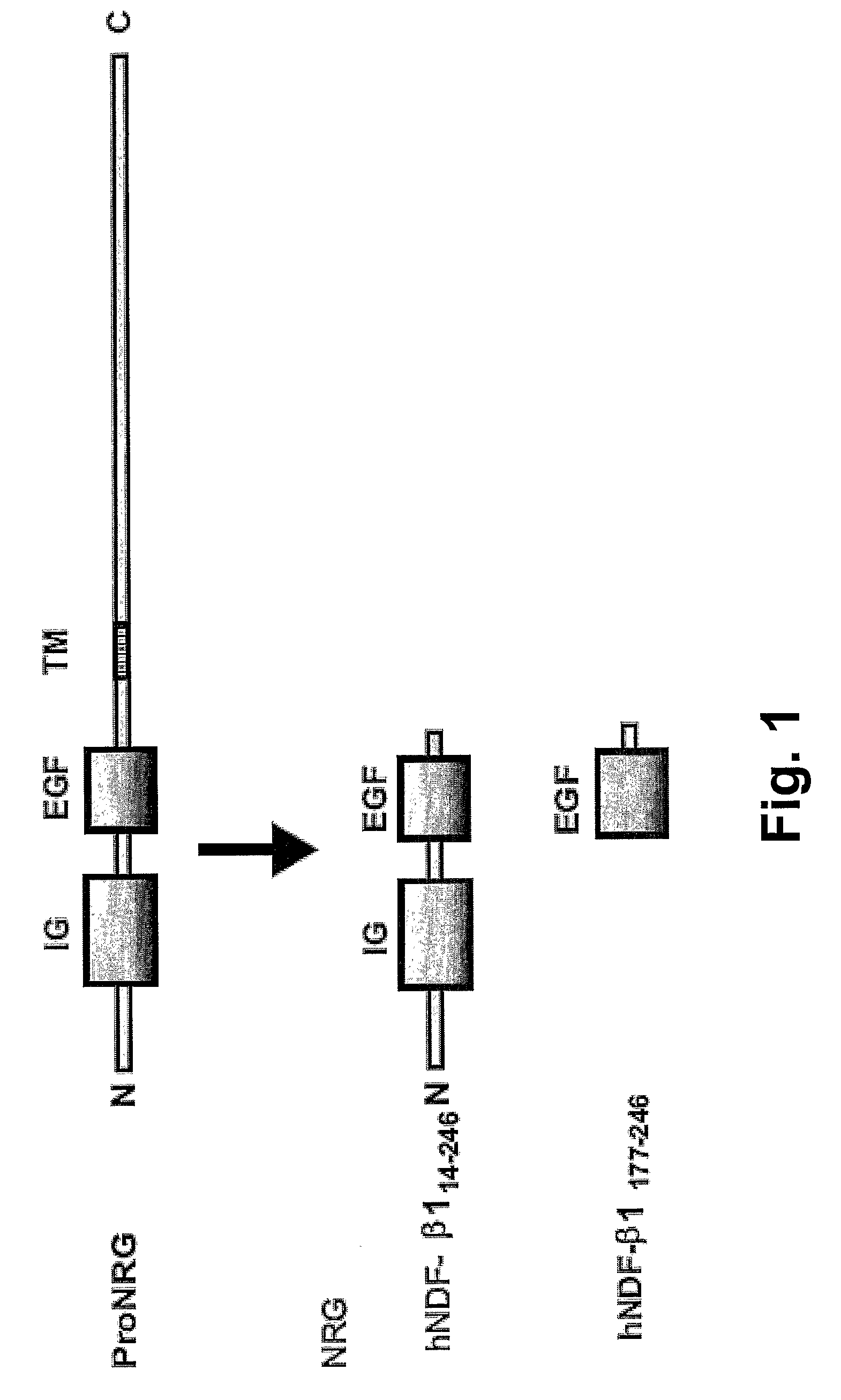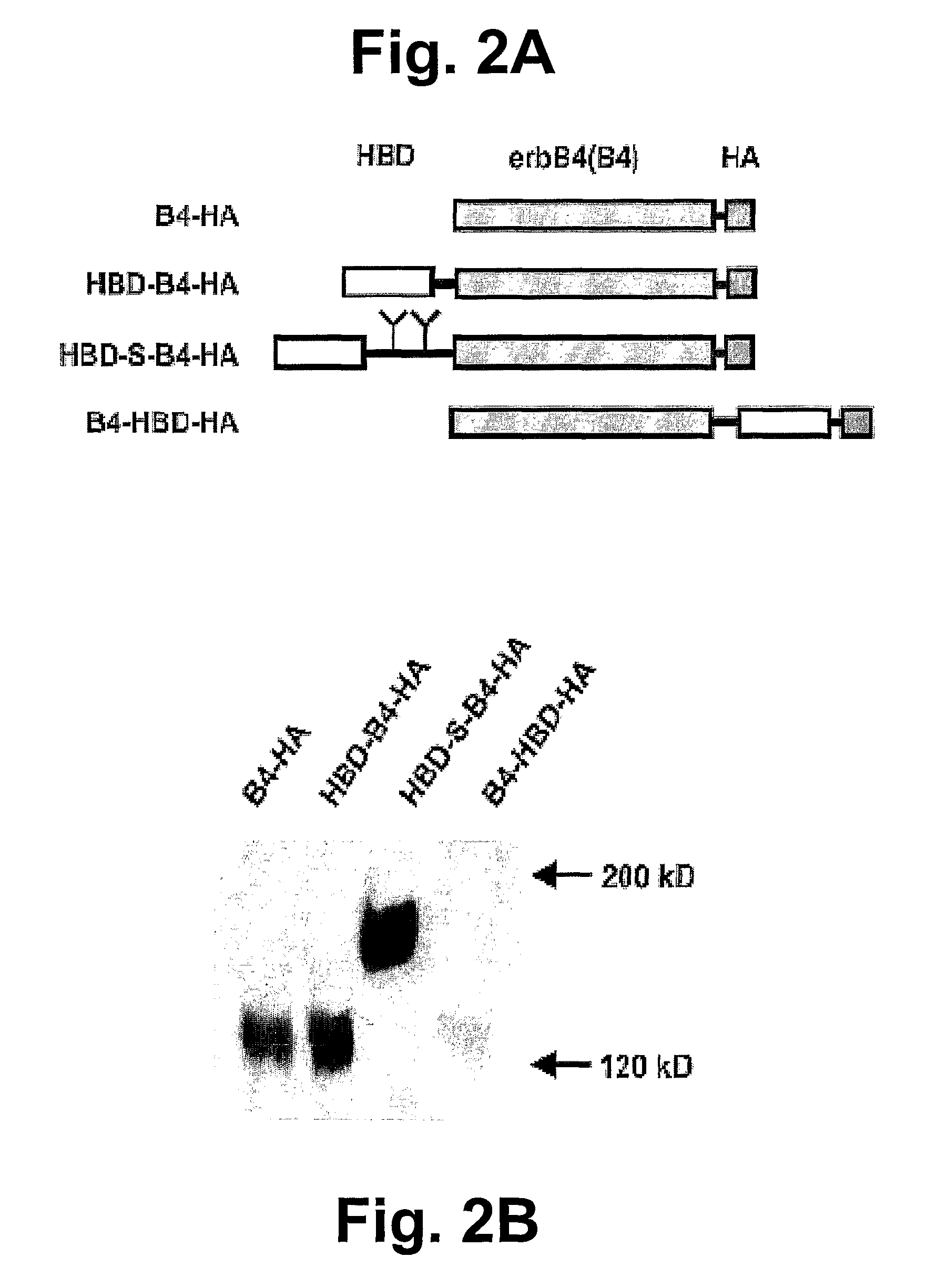Hybrid proteins with ErbB4 extracellular domain and neuregulin heparin-binding domain for targeting
a technology of erbb4 extracellular domain and neuregulin, which is applied in the field of biochemistry, neuroscience and medicine, can solve the problems of high concentration, practically unattainable, and achieve the effects of enhancing and increasing the biological activity of the protein
- Summary
- Abstract
- Description
- Claims
- Application Information
AI Technical Summary
Benefits of technology
Problems solved by technology
Method used
Image
Examples
example i
Targeting Recombinant NRG Antagonists to the ECM By NRG's Heparin Binding Domain
Materials and Methods
[0257]NRG β1 recombinant protein IG-EGF form which corresponding to amino acid 14-276 was provided by Amgen (Thousand Oaks, Calif.). The NRG antagonist IgB4 construct was a gift from Dr. Y. Yarden (Weizmann Inst., Rehovot, Israel). All the media, buffers and ingredients for cell culture and transfection reagents were purchased from Gibco-Invitrogen Life Science (Carlsbad, Calif.). The heparin column was from Sigma (St. Louis, Mo.). Phosphotyrosine antibody 4G10 was purchased from Upstate Biotechnology Incorporation (Lake Placid, N.Y.); anti-HA monoclonal raw ascites fluid HA.11 was from Covance Inc. (Princeton, N.J.); the anti-HA affinity matrix (3F10) was from Roche (Indianapolis, 1N); Goat anti-mouse secondary antibody was from Chemicon (Temecula, Calif.). The Gelcode SilverSNAP Stain kit was purchased from Pierce Biotechnology (Rockford, Ill.).
2. B4-HA and B4-Fc-HA Construct Prepa...
example ii
Discussion of Example II
[0299]This example shows that progressive malignant transformation of the MCF10 cell line is associated with a loss of NRG's normal anti-proliferative effects and the development of an autocrine NRG signaling loop that stimulates cell proliferation. The MCF10 cell series covers the whole spectrum of tumorigenesis from the fairly normal MCF10A cells, to the pre-malignant MCF10AT cells, to the highly malignant MCF10CA1 cells in a single, isogenic series. Effects of exogenous NRG on this series of cell lines “switched” from anti-proliferative to proliferative as the cells changed from normal to malignant. This was associated with an relative increase in erbB2 and decrease in erbB3 expression. Since erbB2 cannot bind NRG and erbB3 has an inactive tyrosine kinase domain, the change in proportion of erbB2 / 3 could significantly alter NRG binding to erbB3 and signaling through erbB2. While the mechanism for this change in NRG responsiveness may stem from changes in e...
example iii
Discussion of Example III
[0319]Given that virtually all cells express HSPGs and that the list of heparin-binding factors continues to grow, mechanisms are needed to discriminate which factors bind to and concentrate along a given cell surface in response to dynamic requirements during development and throughout life. Variations in the amount of HSPGs and their specific sulfation patterns are ways this could be accomplished. If a certain growth factor is needed, the cell could regulate the expression of enzymes that modify the GAG chains accordingly. In fact, regional specificity in HSPG structure has been observed with anti-heparan sulfate mAbs, each of which stains a unique region of skeletal muscle during development (Jenniskens, G J et al. (2000) J Neurosci 20:4099-4111). The localized expression of two different 6O-sulfotransferase enzymes in the anterior and posterior proximal chick limb bud, respectively, and a more uniform expression of 2O-sulfotransferase throughout the enti...
PUM
| Property | Measurement | Unit |
|---|---|---|
| concentration | aaaaa | aaaaa |
| concentration | aaaaa | aaaaa |
| pH | aaaaa | aaaaa |
Abstract
Description
Claims
Application Information
 Login to View More
Login to View More - R&D
- Intellectual Property
- Life Sciences
- Materials
- Tech Scout
- Unparalleled Data Quality
- Higher Quality Content
- 60% Fewer Hallucinations
Browse by: Latest US Patents, China's latest patents, Technical Efficacy Thesaurus, Application Domain, Technology Topic, Popular Technical Reports.
© 2025 PatSnap. All rights reserved.Legal|Privacy policy|Modern Slavery Act Transparency Statement|Sitemap|About US| Contact US: help@patsnap.com



